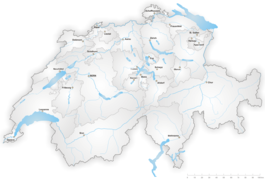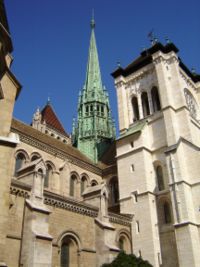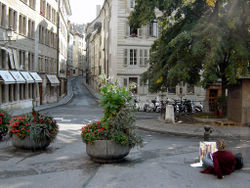Geneva
2007 Schools Wikipedia Selection. Related subjects: European Geography
| Geneva | |
|---|---|
 |
|
| Canton | Geneva |
| District | n.a. |
| Coordinates | |
| Population | 185,526 ( 2004) |
| Area | 15.86 km² |
| Elevation | 375 m |
| Postal code | 1200 |
| Mayor | André Hediger |
| Website | www.ville-ge.ch |
Geneva (pronunciation /dʒənivə/; French: Genève /ʒənɛv/, German: Genf /gɛnf/, Italian: Ginevra) is the second most populous city in Switzerland (after Zürich), and is the most populous city of Romandy (the French-speaking part of Switzerland). It is situated where Lake Geneva (French Lac Léman) flows into the Rhône River, and is the capital of the Canton of Geneva. The population within the city limits is 185,526 ( 2004) and that of the metropolitan area — which extends into France and Vaud — is about 700,000. Geneva is widely regarded as a global city, mainly due to the presence of numerous international organizations, including the European headquarters of the United Nations. A 2006 survey found Geneva to have the second highest quality of living in the world (again, after Zürich).
See Names of European cities in different languages for a list of the name of this city in other languages.
History
Geneva was the name of a settlement of the Celtic people of the Allobroges. The name of Genava (or Genua) in Latin appeared for the first time in the writings of Julius Caesar in De Bello Gallico, his comments on the Gallic Wars. Its name may be identical in origin to the name of the Ligurian city of Genua (modern Genoa), meaning "knee", that is, "angle", referring to its geographical position; though more likely is based on the root gen- 'birth' (Genawa is at the birth of the river from the womb of the lake; perhaps the name in full means 'birth-water'). After the Roman conquest it became part of the Provincia Romana ( Gallia Narbonensis). In 58 BC, at Geneva, Caesar hemmed in the Helvetii on their westward march. In the 9th century it became the capital of Burgundy. Though Geneva was contested among Burgundians and Franks and the Holy Roman Emperors, in practice it was ruled by its Prince-bishops, until the Reformation, when Geneva became a republic.
Due to the work of reformers such as John Calvin, Geneva was sometimes dubbed the Protestant Rome. In the 16th century Geneva was the centre of Calvinism; the St. Pierre Cathedral in what is now called the Old Town was John Calvin's own church. During the time when England was ruled by the Catholic Queen Mary I Tudor, who persecuted Protestants, a number of Protestant scholars fled to Geneva. Among these scholars was William Whittingham who supervised the translation of the Geneva Bible in collaboration with Miles Coverdale, Christopher Goodman, Anthony Gilby, Thomas Sampson and William Cole.
One of the most important events in Geneva's history is l'Escalade (literally: "the scaling of the wall"). For the people of Geneva, l'Escalade is the symbol of their independence. It marked the final attempt in a series of assaults mounted throughout the 16th century by Savoy, which wanted to annex Geneva as its capital north of the Alps. This last assault happened on the night of 11- 12 December 1602 and is celebrated yearly in the Old Town with numerous demonstrations and a parade of horses, cannons and armed men in period costumes.
Geneva, or officially the Canton & Republic of Geneva, became a canton of Switzerland in 1815. The first of the Geneva Conventions was signed in 1864, to protect the sick and wounded in war time.
Geography
Geneva is located at 46°12 North, 6°09' East, at the south-western end of Lake Geneva, where the lake flows into the Rhône River. It is surrounded by two mountain chains, the Alps and the Jura.
The city of Geneva has an area of 15.86 km², while the area of the Canton of Geneva is 282 km², including the two small enclaves of Céligny in Vaud. The part of the Lake that is attached to Geneva has an area of 38 km² and is sometimes referred to as Petit lac (small lake). The Canton has only a 4.5 km border with the rest of Switzerland; out of a total of 107.5 km of borders, the remaining 103 are shared with France, with the Départment de l'Ain to the North and the Département de la Haute-Savoie to the South.
The altitude of Geneva is 373.6 m, and corresponds to the altitude of the largest of the Pierres du Niton, two large rocks emerging from the lake which date from the last ice age. This rock was chosen by General Guillaume Henri Dufour as the reference point for all surveying in Switzerland .
The second main river of Geneva is the Arve River which flows into the Rhône River just west of the city centre.
Demographics
As of 2004, the population of the Commune (city) of Geneva was 185,526, while 438,500 people lived in the Canton of Geneva; around 700,000 people live in the Geneva urban community, which extends into Vaud Canton and neighboring France.
The population of the Canton is split between 145,200 people originally from Geneva (33.1%), 123,400 Swiss from other cantons (28.2%) and 169,000 foreigners (38.7%), from 180 different countries. Including people holding multiple citizenship, 54.4% of people living in Geneva hold a foreign passport.
While Geneva is usually considered as a Protestant city, there are now more Roman Catholics (39.5%) than Protestants (17.4%) living in the Canton. 22% of the inhabitants indicate that they are not part of any religion, the rest being shared between Islam (4.4%), Judaism (1.1%), other religions and people who did not respond. (2000 figures.)
International organizations
Geneva is the seat of many international organizations, including the European headquarters of the United Nations and several other international bodies, such as the World Health Organization, the International Labour Organization, the United Nations High Commissioner for Refugees, the United Nations High Commissioner for Human Rights, the World Intellectual Property Organization, the International Telecommunication Union, the World Meteorological Organization, the World Trade Organization and the Inter-Parliamentary Union. Geneva also hosts the European Organization for Nuclear Research, or CERN, the International Organization for Standardization, the International Baccalaureate program, the Airports Council International, the World Council of Churches, the World Wide Web Virtual Library, the World Economic Forum, World Organization of the Scout Movement, International Committee of the Red Cross and the International AIDS Society.
Geneva was the seat of the League of Nations between 1919 and the league's dissolution in 1946. It was first housed in the Palais Wilson, and then in the Palais des Nations, which now hosts the United Nations.
Economy
Geneva's economy is mainly services oriented. The city has an important and old finance sector, which is specialized in private banking (managing assets of about 1 trillion USD) and financing of international trade. It is also an important centre of commodity trade.
Geneva is the international headquarter of companies like Serono, STMicroelectronics, Société Générale de Surveillance, Mediterranean Shipping Company and SITA. Many other multinational companies like Procter & Gamble, DuPont, INVISTA, Hewlett-Packard, JT International (JTI), Electronic Arts and Sun Microsystems have their European headquarters in the city too.
There is a long tradition of Watchmaking ( Rolex, Patek Philippe, Baume et Mercier, Franck Muller). Two major international producers of flavours and fragrances, Firmenich and Givaudan, have their headquarters and main production facilities in Geneva.
Many people also work in the numerous offices of international organizations located in Geneva (about 24000 in 2001).
Infrastructure
Transportation
The city is served by the Geneva Cointrin International Airport. It is connected to both the Swiss railway network SBB-CFF-FFS, and the French SNCF network, including direct connections to Paris, Marseille and Montpellier by TGV. Geneva is also connected to the motorway systems of both Switzerland ( A1 motorway) and France.
Public transport by bus, trolleybus or tram is provided by Transports Publics Genevois (TPG). In addition to an extensive coverage of the city centre, the network covers most of the municipalities of the Canton, with a few lines extending into France. Public transport by boat is provided by the Mouettes Genevoises, which link the two banks of the Lake within the city, and by the Compagnie générale de navigation (CGN) who serve more distant destinations such as Nyon, Yvoire, Thonon, Evian and Lausanne.
Trains operated by SBB-CFF-FFS connect the airport to the main station of Cornavin in a mere 6 minutes, and carry on to towns such as Nyon, Lausanne, Montreux, Neuchâtel, Berne, Sion, Sierre, etc. Regional train services are being increasingly developed, towards Coppet and Bellegarde. At the city limits, two new stations have been created since 2002: Genève-Sécheron (close to the UN and the Botanical Gardens) and Lancy-Pont-Rouge.
In 2005, work started on the CEVA (Cornavin - Eaux-Vives - Annemasse) project, first planned in 1884, which will connect Cornavin with the Cantonal hospital, the Eaux-Vives station and Annemasse, in France. The link between the main station and the classification yard of La Praille already exists; from there, the line will go mostly underground to the Hospital and the Eaux-Vives, where it will link up to the existing line to France. Support for this project was obtained from all parties in the local parliament.
Utilities
Water, natural gas and electricity are provided to the municipalities of the Canton of Geneva by the state-owned Services Industriels de Genève (or SIG). Most of the drinkable water (80%) is extracted from the lake; the remaining 20% is provided by groundwater originally formed by infiltration from the Arve River. 30% of the Canton's needs in electricity are locally produced, mainly by three hydroelectric dams on the Rhone River (Seujet, Verbois and Chancy-Pougny). In addition, 13% of the electricity produced in the Canton is made from the heat induced by the burning of waste at the waste incineration facility of Les Cheneviers. The remaining needs (57%) are covered by imports from other cantons in Switzerland or other European countries; SIG buys only electricity produced by renewable methods, and in particular does not use electricity produced using nuclear reactors or fossil fuels. Natural gas is available in the City of Geneva, as well as in about two-thirds of the municipalities of the canton, and is imported from western Europe by the Swiss company Gaznat. SIG also provides telecommunication facilities to carriers, service providers and large enterprises. From 2003 to 2005 "Voisin, voisine" a Fibre to the Home pilot project with a Triple play offering was launched to test the end-user market in the Charmilles district.
Education
Geneva is home to one of the oldest universities in the world, the University of Geneva, founded by John Calvin in 1559. Also, the oldest international school in the world is located in Geneva, the International School of Geneva, founded in 1924 along with the League of Nations.
The city is also home to one of the most prestigious graduate schools of international relations, the Graduate Institute of International Studies. Other International schools include Geneva English School and Institut International de Lancy (founded in 1903).
The Geneva School of Diplomacy and International Relations is a private university located on the grounds of the Chateau de Penthes, an old manor with a park and view of Lac Leman.
The Canton of Geneva's public school system has "Ecoles Primaires" (4-12), "Cycles D'Orientation" (12-15), and the post-obligatory "Collèges" (15-19), the oldest of which is the Collège Calvin. It is housed in the ancient buildings of the University of Geneva, and could be considered one of the oldest public schools in the world.
Culture
Landmarks and Sights
Notable sights in Geneva include the International Museum of the Reformation, the Reformation Wall, the Flower Clock, the Art and History Museum, the International Red Cross and Red Crescent Museum and the Palais des Nations, which serves as the European headquarters of the United Nations.
The city's most visited monument is the Saint-Pierre Cathedral, located at Cour Saint-Pierre, a noteworthy space of unique spiritual and cultural importance. The Cathedral and towers, which both embody the high point of the Reformed tradition and explores the origins of Christianity in its archaeological site, is now complemented by the International Museum of the Reformation, on the ground floor of the Maison Mallet. An underground passage, reopened when the Museum was created, connects the two buildings and a pass is now available for visitors to enjoy all three areas.
The city's most noted landmark is a fountain: the Jet d'Eau (water-jet), situated in Lake Geneva. Its 140-metre-high water column is visible from many parts of the city.
Theatre
Within this multicultural society, English theatre flourishes, the key groups include Geneva English Drama Society (GEDS), Geneva Amateur Operatic Society (GAOS), Howard Productions and Simply Theatre.
Sport
The main sport team in Geneva is Servette FC, a football club founded in 1890 and named after a borough on the right bank of the Rhône River. Servette was the only club to have remained in the top league in Switzerland since its creation in the 1930s; however, in 2005, management problems caused the bankruptcy of the club's parent company, causing the club to be demoted two divisions lower. Geneva is also home of the Geneve Servette Hockey Club, which is currently playing in the first league.
Communities
As the Geneva authorities say, the history of the city is closely related to that of the foreign communities. Ever since the migration of foreigners to Geneva, these communities have found refuge, bringing their know-how, their customs and hope of a new life. They have widely participated in the international influence of Geneva, to its economic prosperity, and also to the spreading of views and of science.
Religious communities
There are quite many communities in Geneva. Religious communities are very diverse. Even if Geneva is supposed to be the Protestant Rome, many religions meet in Geneva. Beside the Protestants, the Catholics have been more and more numerous thanks to immigration from latin countries. The Jewish community is one of the oldest of Switzerland, and the more recent Muslim community is emerging in this city which respects all communities.
Foreign communities
Even though Geneva is not a very large metropolis on the world scale, foreign communities are extremely diverse and numerous due to the fact that many UN agencies and NGOs are based in Geneva. Basically every nationality is represented in Geneva. Expatriates, including short-term ones, play an important part in the city's social life. The website Genevaonline (genevaonline.ch) was set up by expats to improve networking among people from different nationalities.
LGBT community
Many other communities or minorities are also very well represented in Geneva, including sexual minorities, with no less than three organizations in Geneva. Dialogai, a gay organization, Lestime, a lesbian organization, and association 360, a mixed organization.
Trivia
Since 1818, a particular chestnut tree is used as the official "herald of the spring" in Geneva. The sautier (secretary of the Parliament of the Canton of Geneva) observes the tree and notes the day of arrival of the first bud. While this event has no practical impact, the sautier issues a formal press release and the local newspaper will usually mention the news. In 2006, the first bud appeared on 14 March.
In 2000, Geneva was awarded the Wakker Prize for the development and preservation of its architectural heritage.
Famous Literature involving Geneva
- Frankenstein by Mary Shelley
- Geneva Nights by Clint Borgen
- " Politics and the Arts" by Jean-Jacques Rousseau






